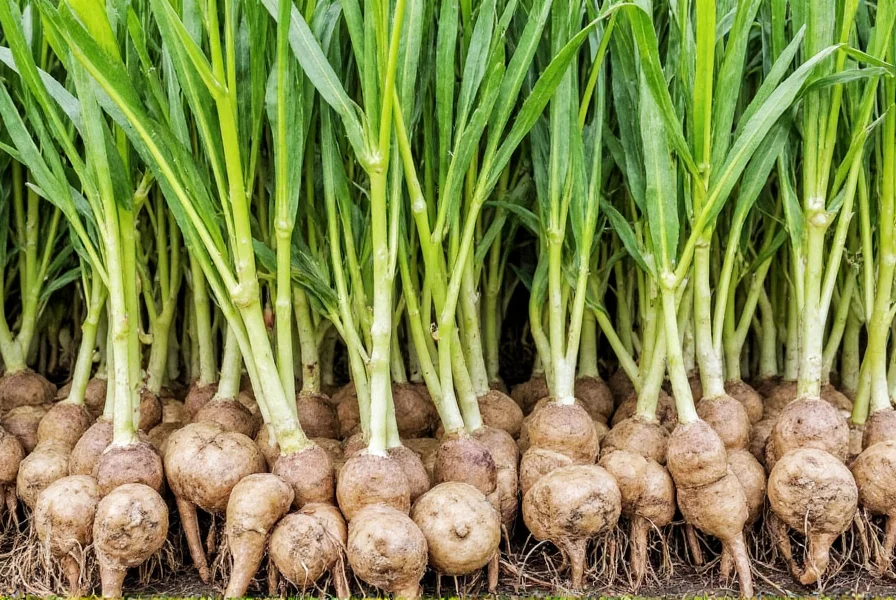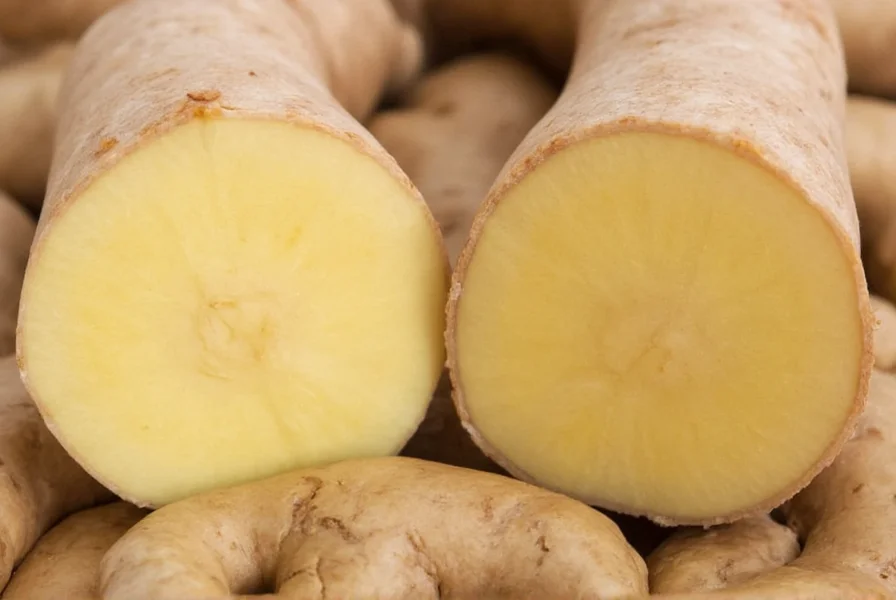When exploring greater galangal vs ginger, it's essential to understand this distinctive rhizome's botanical identity and culinary significance. Unlike common ginger (Zingiber officinale), greater galangal belongs to the Alpinia genus and offers a sharper, more complex flavor profile with subtle pine and citrus notes. This perennial plant can reach heights of 6-10 feet with long, lance-shaped leaves and distinctive pink and white flowers.
Botanical Classification and Identification
Scientifically classified as Alpinia galanga, greater galangal is often confused with its smaller cousin, lesser galangal (Alpinia officinarum). The key identifying features include:
| Characteristic | Greater Galangal | Lesser Galangal |
|---|---|---|
| Scientific Name | Alpinia galanga | Alpinia officinarum |
| Rhizome Size | Large (2-3 inches diameter) | Small (finger-sized) |
| Flavor Profile | Sharp, citrusy, pine notes | Sweeter, more floral |
| Texture | Firmer, less fibrous | More fibrous |
| Primary Use | Culinary (fresh) | Medicinal (dried) |
Geographical Distribution and Cultivation
Native to Indonesia and Malaysia, greater galangal thrives in tropical climates with high humidity and consistent rainfall. Commercial cultivation occurs throughout Southeast Asia, with Thailand being the largest producer. The plant requires well-drained, fertile soil and partial shade, reaching maturity in 8-10 months. Unlike ginger, which grows horizontally, greater galangal develops vertically with rhizomes forming near the soil surface.

Culinary Applications Across Southeast Asia
The difference between greater galangal and lesser galangal becomes most apparent in culinary applications. Greater galangal's robust flavor makes it indispensable in:
- Thai cuisine: Essential in Tom Yum and Tom Kha soups, where it provides the distinctive "ka" flavor
- Indonesian cooking: Key component in rendang and various curry pastes (rempah)
- Malaysian dishes: Foundational in laksa and sambal recipes
- Laotian and Cambodian cooking: Used in traditional fish and meat preparations
When working with fresh greater galangal, chefs typically slice it thinly or pound it into pastes. Unlike ginger, the fibrous core remains tough even after cooking, so many traditional preparations involve bruising the rhizome and removing it before serving—similar to using a bay leaf.
Traditional Medicinal Uses and Research
For centuries, greater galangal has featured prominently in greater galangal benefits traditional medicine systems. Traditional applications include:
- Digestive aid for bloating and stomach discomfort
- Anti-inflammatory treatment for joint pain
- Respiratory remedy for coughs and congestion
- Antimicrobial applications for oral health
Modern research supports some traditional uses, with studies indicating potential anti-inflammatory and antioxidant properties. However, current evidence remains preliminary, and greater galangal should not replace conventional medical treatments for serious conditions.
Storage and Preparation Techniques
Proper handling preserves greater galangal's distinctive flavor. Fresh rhizomes stored in a cool, dark place maintain quality for 2-3 weeks. For longer storage, slice and freeze or preserve in vinegar. When preparing, remove the tough outer skin with a spoon (similar to ginger) rather than a peeler to minimize waste.
For those exploring how to use greater galangal in cooking, remember that its flavor intensifies with cooking time. Add early in the cooking process for deep flavor infusion or later for brighter, more pronounced notes. The characteristic citrus-pine flavor complements coconut milk, lemongrass, and kaffir lime leaves exceptionally well.

Finding and Substituting Greater Galangal
Locating fresh greater galangal can be challenging outside Southeast Asia. Asian grocery stores, particularly those specializing in Thai or Indonesian products, offer the best chance of finding it. When unavailable, acceptable substitutes for greater galangal include:
- Combination of ginger and lemon zest (for culinary use)
- Better substitutes: galangal powder or frozen galangal
- Less ideal: common ginger (lacks the distinctive citrus notes)
Gardeners interested in growing greater galangal in home garden settings should note it requires tropical conditions. In temperate climates, grow in containers that can be moved indoors during colder months. The plant prefers rich, moist soil and partial shade, reaching harvestable size in 8-10 months.
Conclusion
Greater galangal's unique flavor profile and cultural significance make it irreplaceable in authentic Southeast Asian cooking. Understanding the greater galangal vs ginger comparison helps cooks appreciate its distinctive contribution to regional cuisines. While substitutes exist, nothing replicates the complex citrus-pine notes that define dishes where greater galangal plays a starring role. As interest in global cuisines grows, this once-obscure rhizome continues gaining recognition among adventurous home cooks and professional chefs alike.
What is the primary difference between greater galangal and regular ginger?
Greater galangal (Alpinia galanga) has a sharper, more complex flavor with citrus and pine notes compared to ginger's warmer, spicier profile. Botanically, they belong to different genera within the ginger family, with galangal having a firmer texture and lighter color than common ginger.
Can I substitute ginger for greater galangal in recipes?
While possible in a pinch, ginger makes an imperfect substitute as it lacks galangal's distinctive citrus-pine notes. For better results, combine ginger with a small amount of lemon zest or use galangal powder if available. Authentic Southeast Asian dishes particularly suffer when substituting ginger for greater galangal.
How should I store fresh greater galangal to maintain freshness?
Store unpeeled greater galangal rhizomes in a cool, dark place for 2-3 weeks. For longer storage, slice and freeze in an airtight container, or preserve in vinegar. Avoid refrigeration as cold temperatures can damage the rhizome's texture and flavor.
Where can I find greater galangal outside Southeast Asia?
Look for fresh greater galangal at Asian grocery stores, particularly those specializing in Thai or Indonesian products. Some larger supermarkets carry it in the international section. Online retailers and specialty spice merchants often sell frozen or powdered forms when fresh is unavailable.
Is greater galangal used differently in cooking than lesser galangal?
Yes, greater galangal is typically used fresh in cooking, while lesser galangal is more commonly dried and used medicinally. Greater galangal's larger size and firmer texture make it better suited for soups and curries where it's added whole and removed before serving, similar to a bay leaf.
Frequently Asked Questions
What is the primary difference between greater galangal and regular ginger?
Greater galangal (Alpinia galanga) has a sharper, more complex flavor with citrus and pine notes compared to ginger's warmer, spicier profile. Botanically, they belong to different genera within the ginger family, with galangal having a firmer texture and lighter color than common ginger.
Can I substitute ginger for greater galangal in recipes?
While possible in a pinch, ginger makes an imperfect substitute as it lacks galangal's distinctive citrus-pine notes. For better results, combine ginger with a small amount of lemon zest or use galangal powder if available. Authentic Southeast Asian dishes particularly suffer when substituting ginger for greater galangal.
How should I store fresh greater galangal to maintain freshness?
Store unpeeled greater galangal rhizomes in a cool, dark place for 2-3 weeks. For longer storage, slice and freeze in an airtight container, or preserve in vinegar. Avoid refrigeration as cold temperatures can damage the rhizome's texture and flavor.
Where can I find greater galangal outside Southeast Asia?
Look for fresh greater galangal at Asian grocery stores, particularly those specializing in Thai or Indonesian products. Some larger supermarkets carry it in the international section. Online retailers and specialty spice merchants often sell frozen or powdered forms when fresh is unavailable.
Is greater galangal used differently in cooking than lesser galangal?
Yes, greater galangal is typically used fresh in cooking, while lesser galangal is more commonly dried and used medicinally. Greater galangal's larger size and firmer texture make it better suited for soups and curries where it's added whole and removed before serving, similar to a bay leaf.










 浙公网安备
33010002000092号
浙公网安备
33010002000092号 浙B2-20120091-4
浙B2-20120091-4